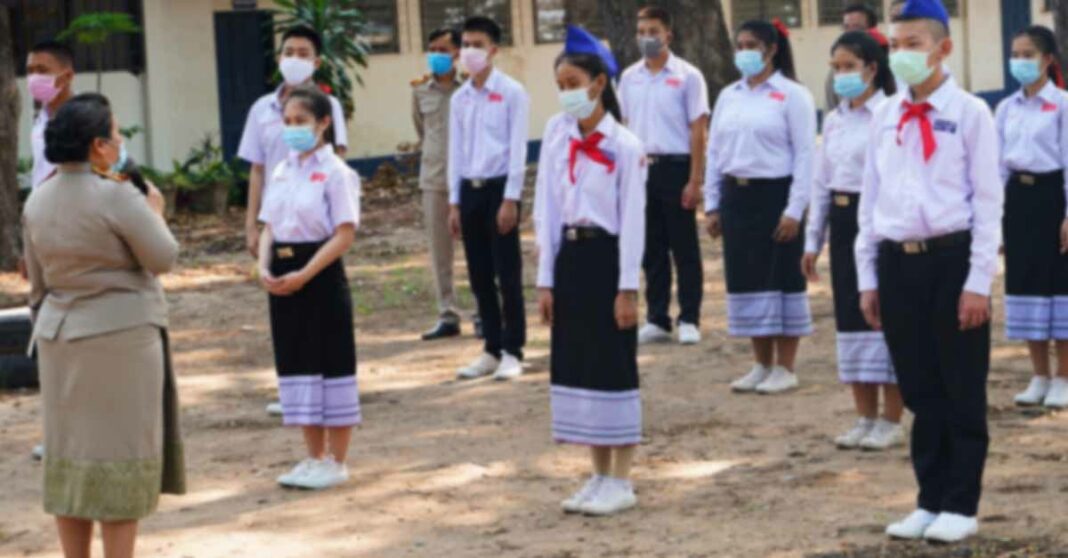Op-ed by WHO, UNICEF, and the Lao Ministry of Health.
Safely reopening schools, and keeping them open, remains an urgent priority amid the threat of the Omicron variant.
In-person school attendance is critical for children’s education and life prospects which will ultimately contribute to human capital development and overall socio-economic development of the country.
Although increased transmissibility across all age groups has been reported for COVID-19 variants of concern, such as Omicron, evidence to date since the start of the pandemic shows that COVID-19 does not pose a higher risk to children and schools are not primary drivers of transmission. When they do contract COVID-19, children tend to have milder symptoms than adults.
“The evidence we have to date shows that if mitigation measures are put in place, it is safe to send children to school,” stated UNICEF Representative to Laos, Dr. Pia Rebello Britto noting that the Lao government has put mitigation measures in place that schools across the country are following.
“We have amassed a large body of knowledge about how to reduce the potential risk of transmission to children, teachers, and their families, including joint WHO-UNICEF guidelines and a WHO schools checklist, that is constantly being reviewed. Using this knowledge, the education and health sectors have successfully worked together toward safely reopening schools in the country and keeping them open, to put children back on the learning track and protect their future,” added Dr. Britto.
The Lao Government has kept the majority of schools open since the start of the new school year in September 2021 with clear guidelines on prevention measures to allow children to return safely to the classroom. Needed supplies such as soaps, hand sanitizers, face masks, and digital thermometers have also been provided to schools with the support of development partners.
“Prolonged school closures and ongoing interruptions to in-class learning have severe adverse consequences, with significant impact on children’s learning and skills attainment and earning prospects, as well as on their physical and mental health, and that of their families. The evidence shows increases in anxiety, depression, and self-harm among school-aged children since the start of the pandemic. School closures have led to reduced physical activity, poor eating habits, and disrupted sleep patterns and collectively, this generation of schoolchildren could lose US$17 trillion in potential lifetime earnings,” said WHO Representative to Laos, Dr. Ying-Ru Jacqueline Lo.
“Achieving the 2030 Sustainable Development Goal for education was already going to be challenging enough before the pandemic, but now, UNICEF and UNESCO estimate that education budgets in the region will need to increase by at least 7% to stay within striking distance of those targets,” added Dr. Lo.
While online education can guarantee some continuity of learning for some children, these services are no substitute for in-person attendance. Access to online learning remains uneven, especially for disadvantaged children who bear the brunt of the shortcomings of digital education. Importantly, for some children, school attendance contributes to a safer living environment, with less time at home decreasing the risk of domestic violence, just as less screen time reduces the risk of online harm.
Over the past few months, we have seen schools in many countries safely stay open and reopen, with additional mitigation measures in place. This includes for example in Japan, the implementation of staggered arrivals and redesigned timetables. In Laos, the government has done everything in its power to keep schools open, including a checklist of mitigation measures developed in close collaboration between the health and education sectors, WHO and UNICEF, along with active engagement with parents and local communities. The school authorities and Village Education Development Committee members also help monitor the implementation of these mitigation measures.
There is no such thing as zero risk – going forward, this means we are still likely to detect cases as a reflection of community transmission, but the risks are manageable with robust mitigation strategies. Policymakers must consider the local context for resuming in-school learning and keeping schools open, including factors such as the level of community transmission and the capacity to detect and respond to an increase in cases.
Now, greater numbers of parents, teaching and other staff, eligible students, and eligible individuals within households are being vaccinated, offering greater community protection against severe illness and death. However, vaccination of children should still not be a pre-requisite for children to go back to the classroom.
There are other ‘safe school’ measures that can be used alongside vaccination as part of a multi-layered approach to reducing COVID-19 transmission. These include proper mask use, physical distancing, adequate ventilation, personal hygiene practices, regular cleaning and disinfection, and promoting a ‘stay home when sick’ policy. If schools with the support of parents and the wider community strictly follow these measures, schools can continue to operate safely, and children can continue learning in the classroom.
Maintaining vigilance, promoting vaccination for eligible groups, and adherence to all of the other measures is critical – not only for schools but also for our broader efforts to suppress COVID-19 transmission in the community. We need to work towards a sustainable approach and move away from school closures or only partial openings, to stay fully open. The consequences of keeping children out of their classrooms are grave and far-reaching. Children must be given the opportunity to thrive again – schools must continue to stay open.
The views expressed in this article are those of its authors do not necessarily reflect the views of the Laotian Times.



